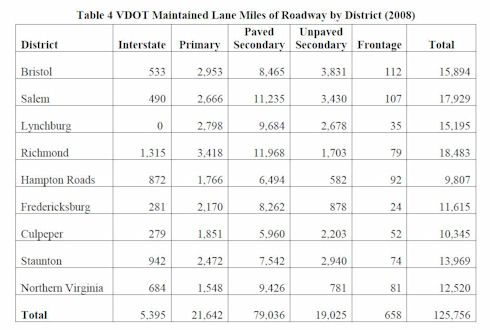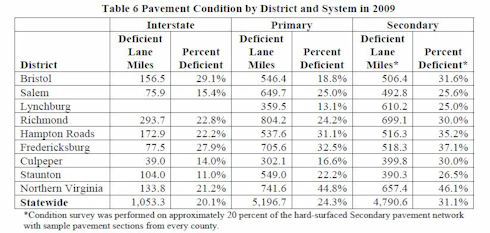Maintenance is consuming Virginia’s transportation budget, and members of a Commonwealth Transportation Board subcommittee agree that the state should change should the way it does business. But urban-rural differences could make it hard to reach agreement.
By James A. Bacon
The commonwealth of Virginia spends roughly $1.4 billion per year to maintain its road system but that massive sum has yet to pay off with smoother roads and sturdier bridges. According to a 2009 report, VDOT rated 31% of the state’s 98,000 miles of secondary road as deficient, a marked deterioration over the previous decade, and tagged 9% of the state’s 19,400 bridges and culverts the same. The Old Dominion doesn't just lack sufficient funds to expand its transportation network, it barely has enough to keep up what it's got.
Meeting for the first time in Richmond Wednesday, a subcommittee of the Commonwealth Transportation Board began reviewing how the state allocates its maintenance dollars. Its object: Determine if the money can be more effectively spent or more equitably distributed.
Although most of the session was devoted to reviewing background material, subcommittee members raised a number of issues that will shape the agenda in a follow-up meeting next month. Urban CBT members made clear their interest in revising VDOT formulas for allocating maintenance funds, which are based on the number of lane-miles of road in the state system. They raised the possibility of distributing funds on the basis of entirely different criteria, such as need, as measured by the condition of roads and bridges, or where investments can generate the highest economic return.
In a session where all members were actively engaged in the discussion, it was W. Sheppard Miller, a Norfolk businessman appointed to the board as an urban at-large member, who most forcefully made the case for an overhaul of the allocation formulas. If he could reinvent the maintenance allocation formula from scratch, Miller asked, why would he create one anything like the one Virginia has now? The current formula, which spreads money around the state irrespective of need or economic payoff, results in a system in which roads in some parts of the state are maintained in superb condition while roads in other areas are deteriorating.
“Does it make sense from a business perspective?" he asked. "I want to invest my scarce maintenance dollars where they give me the greatest return. If I’ve got four bedrooms in my house and one room needs to be painted, I’m not going to paint one wall in each room!”
Miller argued that the lane-mile count is only one among several relevant metrics for prioritizing the allocation of dollars among state highway districts, where VDOT maintains the roads, and cities, towns and two counties (Arlington and Henrico), which maintain their own roads. “What’s the cost of having a poor secondary road system?” he asked. “Is the cost greater around Dulles than Farmville? If Rt. 15 through Prince Edward County isn’t in good shape, what’s the impact on the commonwealth, as opposed to a road through Dulles [airport] or to Hampton Roads? Some lane miles are more important [economically] than others. If I’m in a hurricane and my generator goes out, I’m not so concerned about the light in my attic. I’m very concerned about my refrigerator.”
Gary Garczynski, a Woodbridge developer and at-large urban member, backed Miller’s line of thinking. Allocation formulas must be equitable, he conceded, “but you’ve got to take into account the economic impact on the commonwealth. What’s going to deliver the greatest economic impact for the good of all of the citizens?”
The two rural at-large members, James Keen from Vansant in Southwestern Virginia and Allen Louderback from Luray in the Shenandoah Valley, did not contest the point but they did offer different perspectives. "We need to look at ways to enhance revenues," Keen said. Louderback cited the rapid growth in the number of lane-miles in fast-growth counties, which resulted in them increasing their shares of the maintenance pot while leaving smaller shares for others. Developers routinely turn over secondary roads inside their subdivisions to the state to maintain. "We can't keep adding things. Maybe we shouldnt."
Subcommittee members also spent considerable time discussing the devolution issue. A recent George Mason University study had concluded that system for maintaining Virginia’s secondary roads was inadequate, that the secondary system was deteriorating, and that it made sense to devolve responsibility for secondary road maintenance to local governments where decisions for development and land-use are made.
“Our secondary road program is facing an enormous array of challenges," said Transportation Secretary Sean Connaughton in a press release highlighting the study’s findings. "VDOT’s current resources are sufficient to do a few missions well or many missions inadequately. This report provides an excellent overview of the choices ahead.” Those choices include such options as imposing devolution upon the counties, empowering counties to raise revenues, outsourcing maintenance work to private contractors and maintaining existing policy.
Although a handful of local governments – Fairfax County and James City County, most notably – have given close study to devolution, most have kept a wide berth. County officials have learned from the experience of cities, which have had to make up the difference when state support falls short. One survey found that on average localities were spending 40% more on maintenance than their state annual state maintenance payments – in other words, supplementing their VDOT funds with local money.
“The localities don’t trust the state to fairly allocate money to pay for road maintenance,” said Louderback. While outsourcing might be one way to shave costs, he added, rules requiring VDOT to review the contracts limit the ability of localities to move quickly on good deals. “We don’t need to send it through Richmond for review and approval.”
There were no signs of discord during the hearing, but the divergent interests of urban and rural board members could surface when subcommittee members are called upon to make concrete recommendations. Rural members will be more supportive of a status quo that favors rural transportation districts by allocating maintenance dollars based on lane miles. Rural districts enjoy a distinct funding advantage over compact but populous regions like Northern Virginia and Hampton Roads, as shown in the chart below.

By contrast, the urban at-large members, two of whom hail from Hampton Roads and one from Northern Virginia, might prefer changing the criteria for secondary road funding to need (based on the condition of roads), which would shift funding to Northern Virginia and to a lesser extent Hampton Roads and Fredericksburg, as seen below.

Likewise, allocating funds on the basis of economic criteria would tend to favor urban areas that experience greater economic losses to congestion and have greater potential for economic development.
If the debate turns into a showdown between urban and rural interests, Hollis Ellis, a Hampton Roads small businessman, could end up the swing vote. He neither supported nor questioned Miller's call for rewriting the allocation formula.
Indeed, the dichotomy of urban-rural interests never surfaced directly. However, Miller did allude to it indirectly in making the case for changing the allocation formulas. “Take five of the most economically impactful areas of the commonwealth and shut them down,” he said. “Guess what, for the rest of the state, it’s game over. If you shut down Northern Virginia and Hampton Roads, we’re done. ... You have to fund the geese who lay the golden eggs.”
=============
This article was reported and written thanks to a sponsorship by the Piedmont Environmental Council.

